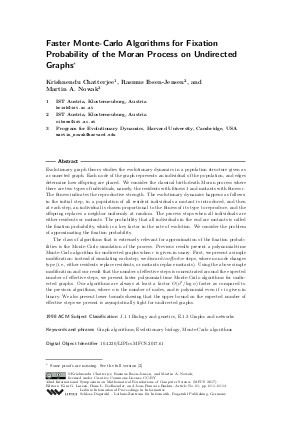Faster Monte-Carlo Algorithms for Fixation Probability of the Moran Process on Undirected Graphs
Authors Krishnendu Chatterjee, Rasmus Ibsen-Jensen, Martin A. Nowak
-
Part of:
Volume:
42nd International Symposium on Mathematical Foundations of Computer Science (MFCS 2017)
Part of: Series: Leibniz International Proceedings in Informatics (LIPIcs)
Part of: Conference: Mathematical Foundations of Computer Science (MFCS) - License:
 Creative Commons Attribution 3.0 Unported license
Creative Commons Attribution 3.0 Unported license
- Publication Date: 2017-12-01
File

PDF
LIPIcs.MFCS.2017.61.pdf
- Filesize: 0.51 MB
- 13 pages
Document Identifiers
Subject Classification
Keywords
- Graph algorithms
- Evolutionary biology
- Monte-Carlo algorithms
Metrics
- Access Statistics
-
Total Accesses (updated on a weekly basis)
0PDF Downloads0Metadata Views
Abstract
Evolutionary graph theory studies the evolutionary dynamics in a population structure given as a connected graph. Each node of the graph represents an individual of the population, and edges determine how offspring are placed. We consider the classical birth-death Moran process where there are two types of individuals, namely, the residents with fitness 1 and mutants with fitness r. The fitness indicates the reproductive strength. The evolutionary dynamics happens as follows: in the initial step, in a population of all resident individuals a mutant is introduced, and then at each step, an individual is chosen proportional to the fitness of its type to reproduce, and the offspring replaces a neighbor uniformly at random. The process stops when all individuals are either residents or mutants. The probability that all individuals in the end are mutants is called the fixation probability, which is a key factor in the rate of evolution. We consider the problem of approximating the fixation probability. The class of algorithms that is extremely relevant for approximation of the fixation probabilities is the Monte-Carlo simulation of the process. Previous results present a polynomial-time Monte-Carlo algorithm for undirected graphs when $r$ is given in unary. First, we present a simple modification: instead of simulating each step, we discard ineffective steps, where no node changes type (i.e., either residents replace residents, or mutants replace mutants). Using the above simple modification and our result that the number of effective steps is concentrated around the expected number of effective steps, we present faster polynomial-time Monte-Carlo algorithms for undirected graphs. Our algorithms are always at least a factor O(n^2/log n) faster as compared to the previous algorithms, where n is the number of nodes, and is polynomial even if r is given in binary. We also present lower bounds showing that the upper bound on the expected number of effective steps we present is asymptotically tight for undirected graphs.
Cite As Get BibTex
Krishnendu Chatterjee, Rasmus Ibsen-Jensen, and Martin A. Nowak. Faster Monte-Carlo Algorithms for Fixation Probability of the Moran Process on Undirected Graphs. In 42nd International Symposium on Mathematical Foundations of Computer Science (MFCS 2017). Leibniz International Proceedings in Informatics (LIPIcs), Volume 83, pp. 61:1-61:13, Schloss Dagstuhl – Leibniz-Zentrum für Informatik (2017)
https://doi.org/10.4230/LIPIcs.MFCS.2017.61
BibTex
@InProceedings{chatterjee_et_al:LIPIcs.MFCS.2017.61,
author = {Chatterjee, Krishnendu and Ibsen-Jensen, Rasmus and Nowak, Martin A.},
title = {{Faster Monte-Carlo Algorithms for Fixation Probability of the Moran Process on Undirected Graphs}},
booktitle = {42nd International Symposium on Mathematical Foundations of Computer Science (MFCS 2017)},
pages = {61:1--61:13},
series = {Leibniz International Proceedings in Informatics (LIPIcs)},
ISBN = {978-3-95977-046-0},
ISSN = {1868-8969},
year = {2017},
volume = {83},
editor = {Larsen, Kim G. and Bodlaender, Hans L. and Raskin, Jean-Francois},
publisher = {Schloss Dagstuhl -- Leibniz-Zentrum f{\"u}r Informatik},
address = {Dagstuhl, Germany},
URL = {https://drops.dagstuhl.de/entities/document/10.4230/LIPIcs.MFCS.2017.61},
URN = {urn:nbn:de:0030-drops-81213},
doi = {10.4230/LIPIcs.MFCS.2017.61},
annote = {Keywords: Graph algorithms, Evolutionary biology, Monte-Carlo algorithms}
}
Author Details
References
- B. Adlam, K. Chatterjee, and M. A. Nowak. Amplifiers of selection. Proceedings of the Royal Society of London A: Mathematical, Physical and Engineering Sciences, 471(2181), 2015. URL: http://dx.doi.org/10.1098/rspa.2015.0114.
- Krishnendu Chatterjee, Rasmus Ibsen-Jensen, and Martin Nowak. Faster monte-carlo algorithms for fixation probability of the moran process on undirected graphs. CoRR, abs/1706.06931, 2017. URL: http://arxiv.org/abs/1706.06931.
-
F. Débarre, C. Hauert, and M. Doebeli. Social evolution in structured populations. Nature Communications, 2014.

-
Josep Díaz, Leslie Ann Goldberg, George B. Mertzios, David Richerby, Maria Serna, and Paul G. Spirakis. On the fixation probability of superstars. Proceedings of the Royal Society A: Mathematical, Physical and Engineering Science, 469(2156), 2013.

-
Josep Díaz, Leslie Ann Goldberg, George B. Mertzios, David Richerby, Maria Serna, and Paul G. Spirakis. Approximating Fixation Probabilities in the Generalized Moran Process. Algorithmica, 69(1):78-91, 2014 (Conference version SODA 2012).

-
Josep Díaz, Leslie Ann Goldberg, David Richerby, and Maria Serna. Absorption time of the Moran process. Random Structures &Algorithms, 48(1):137-159, 2016.

-
W.J. Ewens. Mathematical Population Genetics 1: I. Theoretical Introduction. Interdisciplinary Applied Mathematics. Springer, 2004.

-
Marcus Frean, Paul B. Rainey, and Arne Traulsen. The effect of population structure on the rate of evolution. Proceedings of the Royal Society B: Biological Sciences, 280(1762), 2013.

-
Andreas Galanis, Andreas Göbel, Leslie Ann Goldberg, John Lapinskas, and David Richerby. Amplifiers for the Moran Process. In 43rd International Colloquium on Automata, Languages, and Programming (ICALP 2016), volume 55, pages 62:1-62:13, 2016.

-
Rasmus Ibsen-Jensen, Krishnendu Chatterjee, and Martin A Nowak. Computational complexity of ecological and evolutionary spatial dynamics. Proceedings of the National Academy of Sciences, 112(51):15636-15641, 2015.

-
Samuel Karlin and Howard M. Taylor. A First Course in Stochastic Processes, Second Edition. Academic Press, 2 edition, April 1975.

- Erez Lieberman, Christoph Hauert, and Martin A. Nowak. Evolutionary dynamics on graphs. Nature, 433(7023):312-316, January 2005. URL: http://dx.doi.org/10.1038/nature03204.
-
P. A. P. Moran. The Statistical Processes of Evolutionary Theory. Oxford University Press, Oxford, 1962.

-
Martin A. Nowak. Evolutionary Dynamics: Exploring the Equations of Life. Harvard University Press, 2006.

-
Paulo Shakarian, Patrick Roos, and Anthony Johnson. A review of evolutionary graph theory with applications to game theory. Biosystems, 107(2):66-80, 2012.

